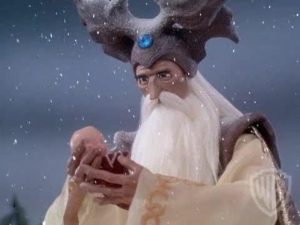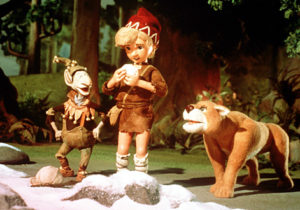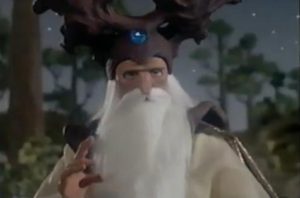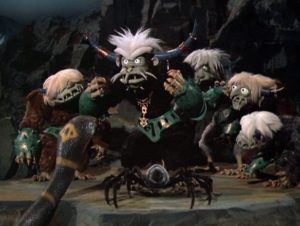
It started in 1964. It ended in 1985. For over 20 years, Rankin-Bass charmed audiences with Christmas specials that incorporated stop-motion, animation, and an ever-present sense of bright eyed wonder. But then, like all things, its time came to an end. So gather the Council of Immortals to watch The Life and Adventures of Santa Claus!

The Life and Adventures of Santa Claus is notable for being adapted from a book rather than a song or poem like so many prior specials. Written by L. Frank Baum, author of The Wizard of Oz, the original novel took place in a fantastical world as imaginative in design as Oz. Rankin-Bass honoured the majority of what was written, throwing away any lingering aspects from the old continuity of Santa Claus is Comin’ to Town and accepting Baum’s story as the new definitive version. There’s a lot of Oz in The Life and Adventures of Santa Claus. To the casual viewer, there’s also a lot of Narnia, and a good amount of Lord of the Rings. Rankin-Bass had made their own animated versions of The Hobbit in 1977 and Return of the King in 1980. These experiences definitely shaped the company and their influence hangs heavy over this special, letting the richness of the lore show itself off in all its splendour.
Unfortunately, that influences means it doesn’t really know how to be a fun Christmas special. Looking around at many later Rankin-Bass specials, including Rudolph’s Shiny New Year and Christmas in July, I noted an increase in lore and world building that definitely defined how I felt they were received. As much as I personally eat that up, I think it’s where they started to lose their focus. There just isn’t that bouncy feeling of joy to The Life and Adventures of Santa Claus, and it sets off that tone right from the start with the sound of a funeral dirge.

The Life and Adventures of Santa Claus employs a framing device that takes place in the Forest of Burzee. The Great Ak wants to convince them to make Santa Claus immortal so he does not die. He describes Santa as a mortal who has won the love of the entire world, soon to be visited by the spirit of death after his final ride. Ak argues he should be granted immortality based on this love and begins to tell the story of his life. The framing device is a nice way to show off the deep fantasy elements early on, fully announcing how different from Santa Claus is Comin’ to Town this is going to be. It also allows the inclusion of Ak as a narrator to the story. It’s one of the best narrative decisions Rankin-Bass would make in later years, and is definitely the superior format for telling this story compared to the strictly linear narrative of the original book.
As if to remind you of its importance, the first song of The Life and Adventures of Santa Claus is titled Ora e Sempre which plays as the Council of Immortals are introduced. The introductions are very Lord of the Rings. The Queen of the Water Spirits, the King of the Sleep Phase, the Master of the Sound Imps, the Commander of the Wind Demons, the Grand Duke of the Light Elves with the Princess Flash and Twilight, the Protector of the Nooks, and the King of the Ryles, all enter to the steady pace of a deep bass vocal choir. There’s a feeling of importance to these characters, which makes sense, as this discussion of the council took up a good third of the original book, but since we’re condensing the narrative, many of these figures will be voiceless seat-fillers in the telling of Ak’s story, though I’m honestly okay with that for the time being.
Interestingly, we still begin with a newborn baby found abandoned in the snow, as if nobody really wants to get into the question of Santa’s parentage. The Great Ak discovers him in the woods and gives him to the lioness Sheagra to drink lion’s milk and be raised in the wild. He makes a declaration that the babe is to be unharmed by any animal, but in the act, Ak unknowingly becomes a father to the nameless babe. His desire to protect the child is clear, and Ak has immeasurable power in that regard.

The nymphs of the forest do not know or even understand what children are, and need the concept explained to them in A Child, a song that sounds like it was the b-side to a Christoper Lee single. It’s here that we encounter something I really didn’t like about the special, in that Necile the nymph is baby crazy. This is wrong. It’s not a requirement for women to have children and it’s a Christian thought coming into this decidedly pagan world that demands she be this way. They name the child “Little Claus” and allow Necile to be his mother.
The Life and Adventures of Santa Claus focusses on Santa’s childhood far more than Santa Claus is Comin’ to Town ever did, lingering on his time as a baby and toddler through a rather charming montage. As a boy, Little Claus learns the languages of all animals from Tingler, a sound imp. Tingler is original to this special and his main purpose is to give Claus someone to talk to.

Claus accompanies Ak on a journey through the world, reminiscent of Scoorge’s journey with the spirits, albeit on a bigger scale. Little Claus in his adolescence sounds like Luke Skywalker whining about power converters. They fly across the oceans to see European serfs picking turnips, and Claus learns about man’s inhumanity to man. It seems Santa can only be born in the face of injustice. He immediately sees the worst of the autocracy and bourgeoisie. In further stops, he learns of children forced to grow up before their time. He learns of poverty and war. The world, he learns, is a hard and cruel place. But it’s where he has to live.
Claus moves to the Laughing Valley of Hohaho. It’s interesting that this isn’t the North Pole, that this version of Santa is far less isolated than any other. It seems to straddle both worlds, giving Claus the opportunity to live among mortals without straying too far from the Great Ak’s watchful eye. Like a young adult moving within walking distance of his parents, Claus could still probably bring his laundry home if so inclined. Privilege is tricky like that, in that it can sneak up on you. A village seems to spring up around his home in the Laughing Valley and Claus lives his life and gives to the community, growing from a young man into a full grown leader with a bushy blond beard.
One night, Claus finds a boy frozen with cold outside of his home. Weekum. This is, interestingly, the same way Ak found Claus, but other than an innate desire to help a child, Claus doesn’t see him as a son at all. In many ways, it’s because Claus is still a child himself. He’s been protected by the Great Ak all his life and, although shown hardships in a strictly academic sense, he’s never actually had to experience any himself. Weekum lives in an orphanage and is taken in for the night. To brighten his spirits, Claus carves an image of his cat Blinky out of wood. An idol, perhaps. In this continuity, Claus invents the toy. It seems he is ASTOUNDED by the very idea of it, and the joy it brings to Weekum fills him with a sense of purpose. He soon has the ryles, rooks, and wood nymphs building toys in his workshop. But just as things seem to be on track, someone throws a rock through the window with a message that changes everything.
“Mr. Claus, if you make another toy, we’re coming for you. Signed, King Awgwa.”
Because of course, Claus can only grow to become Santa Claus if he’s been steeled by hardship. This is a great way to do it. By giving Claus a direct opponent to his newfound cause, Claus will finally have to prove himself as a mortal man without the help of immortals. That, or dad can come in and fix it for him.

But first some lore. The Awgwas influence children to do bad things. Their homes are in the mountains and they can make themselves invisible. They are straight up boogeymen with a definite racial component to their design that I am uncomfortable with to say the least. They steal from Claus at first, denying the children of his village toys because it makes them happy and less prone to get in trouble. When Claus shows a stubborn streak, they tie him and Sheagra up and take them hostage in the night.
Soon, Claus is tied up in a cave with a giant snake and spider approaching to kill him in cold blood. Claus yells for the Nooks of the forest to help him and the protection from harm his father placed upon him as a baby takes holds. They’re at a stalemate. They can’t kill Claus, but he can’t deliver presents with them stealing his toys every night either.

The Great Ak calls the Awgwa leaders to meet. It’s important to note that this intervention is entirely unprompted by Claus and is entirely Ak’s doing. Santa Claus has never had a father figure through any of these specials, and as much as Ak would not admit it, he is acting as one here, imbuing Claus with the greatest sense of privilege I’ve ever seen. From saving him from the cold, to his actions here, to his calling of the council of immortals, Claus has had the road to success paved for him. Not once is there a victory he has won solely on his own. He gets there simply by being Ak’s “son”. Honestly, it feels like there’s a possibility of a small, million dollar loan coming into this at some point to help Claus start up his first business. But anyway, it’s here Ak makes his intentions known. If the Awgwas continue posing a threat to Claus, IT IS WAR.
There is a battle. Unfortunately, as much as this battle tries to be Lord of the Rings, Helms Deep is just isn’t. The Great Ak fights with a great silver axe to cut down his enemies, which is cool. The Awgwa have a dragon to incinerate the nymphs, which is even cooler. But the sense of scale that’s so desperately needed here is just entirely absent. “FORWARD IMMORTALS, CHARGE!” yells Ak to the, like, six nymphs he brought with him. I can tell it wants to be more, but it ends up being as gritty and intense as the fight scenes in Hook. Just too silly to take seriously. I’d actually love to go back and read The Life and Adventures of Santa Claus because I bet this is a killer moment in the book, but here? Nah.
With the Awgwas defeated, the gift-giving can resume, but Claus can’t drag all the toys in a sack alone anymore. He needs to carry them via a sleigh with reindeer he borrows from Peter Knook. They cross the valley in just a few leaps, nearly flying through the hills. Unable to walk through the front door of houses at night, he goes down the chimney and slips presents into stockings drying by the fire as a surprise. He has begun a tradition that would carry on, says Ak, for nearly 50 years of yearly visits around the globe.
The final scenes of The Life and Adventures of Santa Claus are more reflective, with the mortality of Santa Claus (as he has been known since the first official Christmas Eve) being touched upon more directly. We find him outside his home decorating a tree with colourful decorations. His tone seems wistful, “I am only a mortal and all mortal life fades, but this tree with its decorations will remind you of how we delivered presents to children all over the world”.

Santa is dying in his bed, the end of a mortal life well lived. It’s fitting that this symbol of Christmas itself is on its deathbed in the last Christmas special. But the Council of Immortals have made their decision, and the Mantle of Immortality is bestowed, revitalising the old man. It’s Rankin-Bass saying goodbye at the point of their natural death, but accepting that their legacy will live on forever. I think that’s right.
Overall, I can’t help but keep thinking about how appropriate The Life and Adventures of Santa Claus is as a finale to the original Rankin-Bass canon. It started with the story of an oppressed misfit and ended with a privileged hero. Its attempts at a grand sweeping narrative were hindered by both the 50 minute running time and an unwillingness to commit fully to a more adult tone, but the thematic elements are pitch-perfect.
- Rudolph the Red-Nosed Reindeer
- Frosty the Snowman
- Santa Claus is Comin’ to Town
- Twas the Night Before Christmas
- Rudolph’s Shiny New Year
- Rudolph and Frosty’s Christmas in July
- Frosty’s Winter Wonderland
- The Year Without a Santa Claus
- The Life and Adventures of Santa Claus
- Nestor the Long-Eared Donkey
- The Little Drummer Boy
- The First Christmas Snow
We have one more article to come, wrapping up all the specials I wasn’t able to include on this list. It’s been a thrilling ride, and I have way more of an understanding for how these specials worked than I did when I set out. I have developed a huge amount of respect for Romeo Muller, the writer of 8/10 specials on this list, including Rudolph the Red-Nosed Reindeer, Frosty the Snowman, and Santa Claus is Comin’ to Town. The Life and Adventures of Santa Claus didn’t have everything I look for in a Rankin-Bass special, but it made me appreciate what was missing. And it gave me so much material for a Rankin-Bass themed D&D campaign, so there’s that.

![[PODCAST] THE COMICS AGENDA: THERE IS CHAOS IN US](https://geekd-out.com/wp-content/uploads/2017/11/comics-agenda-2-150x150.jpg)
![[REVIEW] BLACK PANTHER #1](https://geekd-out.com/wp-content/uploads/2023/06/black-panther-1-feat-150x150.jpg)